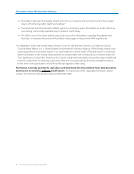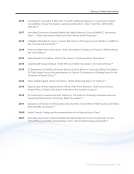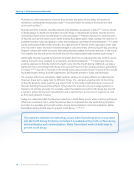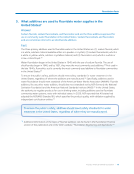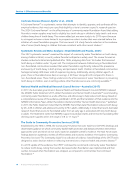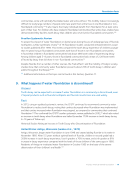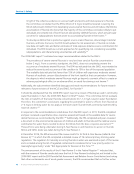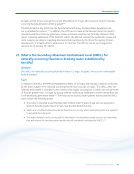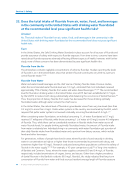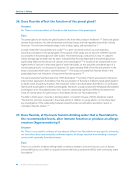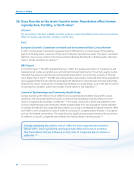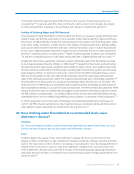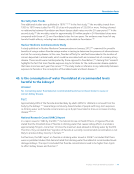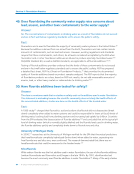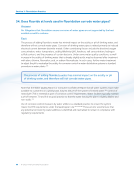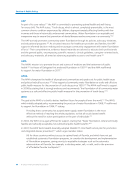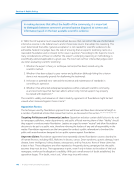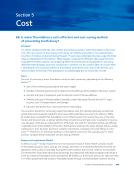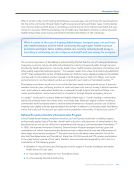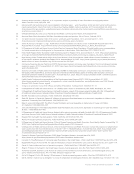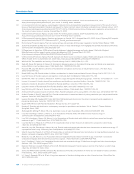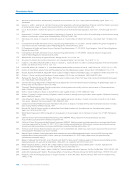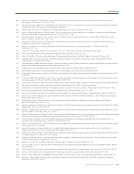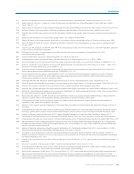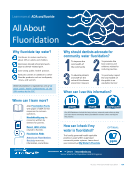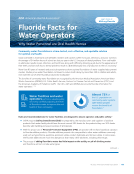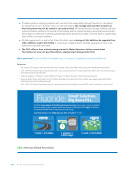98 l © 2025 American Dental Association
Section 4: Public Policy
aspects of fluoridation, the courts have dealt with this concern by ruling that: (1) fluoride is a nutrient,
not a medication, and is present naturally in the environment (2) no one is forced to drink fluoridated
water, as alternative sources are available and (3) in cases where a person believes that fluoridation
interferes with religious beliefs, there is a difference between the freedom to believe, which is
absolute, and the freedom to practice beliefs, which can be restricted in the public’s interest.437,438
Fluoridation is the adjustment of the level of a naturally occurring mineral found in water in order to
prevent tooth decay. Courts have consistently ruled that water fluoridation is not a form of compulsory
mass medication or socialized medicine.434,437,438 In fact, water that has been fortified with fluoride is
similar to fortifying salt with iodine, milk with vitamin D, and orange juice with calcium, all of which are
supplements, not medications.
Interestingly, pro- and anti-fluoridation interests have each won and lost legal challenges regarding
which state or local agency has regulatory authority over fluoridation, which of course varies by state
and locality.432
State law variances have also led to different rulings on other issues, such as whether downstream
end users of fluoridation must be given an opportunity to vote on whether to fluoridate. While cases
decided primarily on procedural grounds have been won and lost by both pro- and anti-fluoridation
interests, to the ADA’s knowledge no final ruling in any of those cases has terminated fluoridation for
reasons on safety and effectiveness.432
Petition to EPA
In November 2016, those opposed to fluoridation filed a legal petition calling for the EPA to ban the
addition of fluoridating chemicals to public drinking water on the grounds that a large body of animal,
cellular, and human research showed that fluoride is neurotoxic at doses within the range now seen in
fluoridated communities in the country (0.7 mg/L).439 The EPA responded to the petition in February
2017 noting, “After careful consideration, EPA denied the TSCA section 21 petition, primarily because
EPA concluded that the petition has not set forth a scientifically defensible basis to conclude that
any persons have suffered neurotoxic harm as a result of exposure to fluoride in the (United States)
through the purposeful addition of fluoridation chemicals to drinking water or otherwise from fluoride
exposure in the (United States).”439 As allowed under the TSCA process, the petitioners filed a lawsuit
challenging the EPA ruling in April 2017 in the US District Court for the Northern District of California
at San Francisco. The trial took place in January and February of 2024.439
Court Ruling September 24, 2024
United States District Court for the Northern District of California
In the case of “Food &Water Watch, Inc. v. United States Environmental Protection Agency,”440 the
court found that the current levels of fluoride used in community water fluoridation in the United
States, specifically 0.7 mg/L, present an unreasonable risk of reduced IQ in children under the Toxic
Substances Control Act (TSCA). This ruling was based largely on the systematic review by the National
Toxicology Program (NTP), which found generally consistent evidence linking high levels of fluoride
exposure at 1.5 mg/L or more to cognitive harm at levels of 1.5 mg/L or higher.192,301
The plaintiffs argued that despite these findings, the EPA had dismissed petitions calling for regulatory
action. In its defense, the EPA raised a number of objections, including uncertainties regarding the
precise hazard level of fluoride and the appropriate metrics for assessing exposure. However, the court
ruled these objections were insufficient to override the risk of harm, even without evidence of harm
at fluoride levels used in community water fluoridation.
Section 4: Public Policy
aspects of fluoridation, the courts have dealt with this concern by ruling that: (1) fluoride is a nutrient,
not a medication, and is present naturally in the environment (2) no one is forced to drink fluoridated
water, as alternative sources are available and (3) in cases where a person believes that fluoridation
interferes with religious beliefs, there is a difference between the freedom to believe, which is
absolute, and the freedom to practice beliefs, which can be restricted in the public’s interest.437,438
Fluoridation is the adjustment of the level of a naturally occurring mineral found in water in order to
prevent tooth decay. Courts have consistently ruled that water fluoridation is not a form of compulsory
mass medication or socialized medicine.434,437,438 In fact, water that has been fortified with fluoride is
similar to fortifying salt with iodine, milk with vitamin D, and orange juice with calcium, all of which are
supplements, not medications.
Interestingly, pro- and anti-fluoridation interests have each won and lost legal challenges regarding
which state or local agency has regulatory authority over fluoridation, which of course varies by state
and locality.432
State law variances have also led to different rulings on other issues, such as whether downstream
end users of fluoridation must be given an opportunity to vote on whether to fluoridate. While cases
decided primarily on procedural grounds have been won and lost by both pro- and anti-fluoridation
interests, to the ADA’s knowledge no final ruling in any of those cases has terminated fluoridation for
reasons on safety and effectiveness.432
Petition to EPA
In November 2016, those opposed to fluoridation filed a legal petition calling for the EPA to ban the
addition of fluoridating chemicals to public drinking water on the grounds that a large body of animal,
cellular, and human research showed that fluoride is neurotoxic at doses within the range now seen in
fluoridated communities in the country (0.7 mg/L).439 The EPA responded to the petition in February
2017 noting, “After careful consideration, EPA denied the TSCA section 21 petition, primarily because
EPA concluded that the petition has not set forth a scientifically defensible basis to conclude that
any persons have suffered neurotoxic harm as a result of exposure to fluoride in the (United States)
through the purposeful addition of fluoridation chemicals to drinking water or otherwise from fluoride
exposure in the (United States).”439 As allowed under the TSCA process, the petitioners filed a lawsuit
challenging the EPA ruling in April 2017 in the US District Court for the Northern District of California
at San Francisco. The trial took place in January and February of 2024.439
Court Ruling September 24, 2024
United States District Court for the Northern District of California
In the case of “Food &Water Watch, Inc. v. United States Environmental Protection Agency,”440 the
court found that the current levels of fluoride used in community water fluoridation in the United
States, specifically 0.7 mg/L, present an unreasonable risk of reduced IQ in children under the Toxic
Substances Control Act (TSCA). This ruling was based largely on the systematic review by the National
Toxicology Program (NTP), which found generally consistent evidence linking high levels of fluoride
exposure at 1.5 mg/L or more to cognitive harm at levels of 1.5 mg/L or higher.192,301
The plaintiffs argued that despite these findings, the EPA had dismissed petitions calling for regulatory
action. In its defense, the EPA raised a number of objections, including uncertainties regarding the
precise hazard level of fluoride and the appropriate metrics for assessing exposure. However, the court
ruled these objections were insufficient to override the risk of harm, even without evidence of harm
at fluoride levels used in community water fluoridation.










